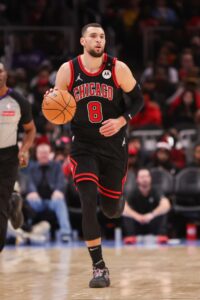The Wizards and Bucks have explored a potential trade that would involve Milwaukee forward Khris Middleton and Washington forward Kyle Kuzma, two league sources tell Josh Robbins and David Aldridge of The Athletic. As we relayed on Monday, Jake Fischer of The Stein Line (Substack link) previously reported that the Bucks have had conversations about pursuing Kuzma.
Swapping Middleton for Kuzma would allow the Bucks to move below the second tax apron, Robbins and Aldridge outline, saving them money and generating more roster flexibility while also allowing them to avoid having their 2032 first-round pick become “frozen” at season’s end.
However, Kuzma is in the midst of the worst season of his career and The Athletic’s duo says the Wizards would be seeking draft capital in order to acquire Middleton, who has battled injuries in recent years.
A straight-up swap of the two players also wouldn’t quite be possible due to the difference in their salaries, so for matching purposes, the Wizards would have to send out a second player along with Kuzma ($23.5MM cap hit; $26.5MM apron hit) in order to take back Middleton ($31.7MM cap hit; $34MM apron hit).
The Bucks are operating about $6.5MM above the second apron and acquiring a second player would keep them above that threshold. So if getting out of second-apron territory is a goal, they’d need to either find a third-team facilitator or send out a second player themselves.
It’s unclear how much traction the two teams have gained in their talks, according to Robbins and Aldridge. When healthy, Middleton is a more valuable all-around player than Kuzma, but he also has been more injury-prone, is four years older, and is more expensive. Middleton holds a $34MM player option for next season, while Kuzma will make $21.5MM in 2025/26 and $19.4MM in ’26/27 on his declining contract.
As for the Wizards, they’re more willing to trade Kuzma now than they were a year ago, when they passed on an opportunity to send him to Dallas, according to The Athletic. But Robbins and Aldridge also note that the forward’s value is at its lowest point, given his struggles this season (.420/.281/.602 shooting), so it may not be the right time for Washington to move him.
Here’s more on the Wizards:
- Washington is interested in using its $12.4MM trade exception to take on an unwanted contract in order to add more future draft assets, league sources tell Robbins and Aldridge. The club is operating nearly $12MM below the tax line, so it could use most of that exception without going into tax territory.
- Malcolm Brogdon, Marvin Bagley III, and Richaun Holmes are among the other players on expiring or pseudo-expiring contracts whom the Wizards are willing to move, according to The Athletic. Bagley and Holmes aren’t positive assets and Brogdon’s trade value probably isn’t better than neutral, but their expiring money could be useful to a team looking to move off a multiyear contract.
- None of the rival teams that have spoken to The Athletic’s duo have heard anything about Jordan Poole being available on the trade market. Poole’s sizable contract remains a potential impediment, but the Wizards are also happy about how he’s performed and bought into the team’s youth movement this season, Robbins and Aldridge explain.
- While Corey Kispert isn’t off the table in trade talks, the poison pill provision will make any deal more challenging and the Wizards have genuine interest in keeping the fourth-year sharpshooter around through their rebuild, league sources tell The Athletic.

 In addition to shedding LaVine’s contract and creating significant short- and long-term cap flexibility, the Bulls will get their very valuable first-rounder back — even if that pick had landed in its protected range this season, Chicago would still have owed a top-eight protected first-rounder to San Antonio in 2026. By reacquiring that pick, the Bulls will regain full control of their first-rounders going forward.
In addition to shedding LaVine’s contract and creating significant short- and long-term cap flexibility, the Bulls will get their very valuable first-rounder back — even if that pick had landed in its protected range this season, Chicago would still have owed a top-eight protected first-rounder to San Antonio in 2026. By reacquiring that pick, the Bulls will regain full control of their first-rounders going forward. “The Warriors are legitimately calling about every All-Star player,” Charania said. “Name the All-Star player, the Warriors have probably called about him. (Sixers forward)
“The Warriors are legitimately calling about every All-Star player,” Charania said. “Name the All-Star player, the Warriors have probably called about him. (Sixers forward)  There had been some
There had been some